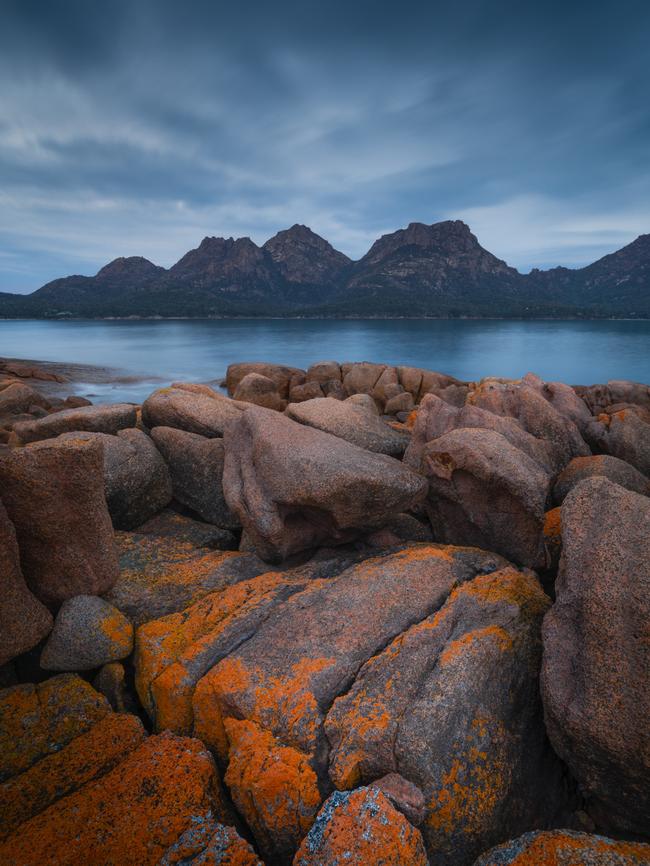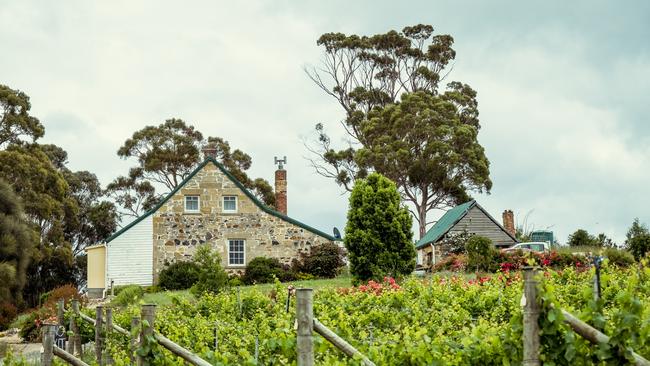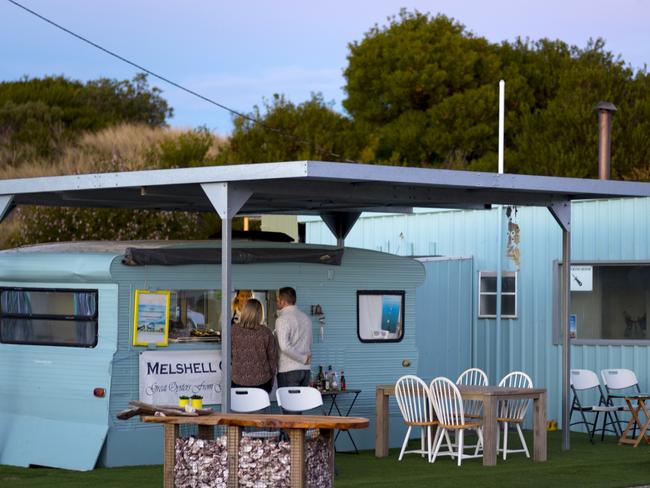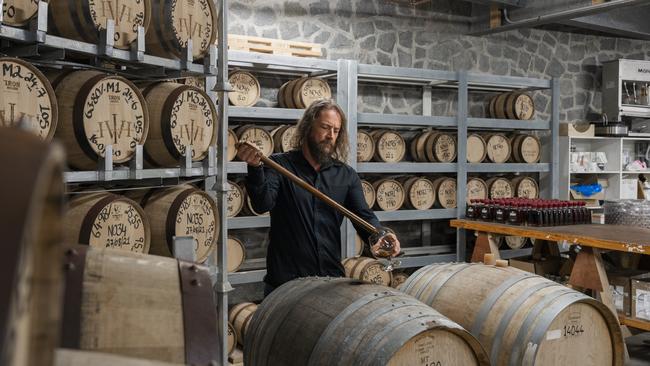East Coast Wine Trail, Tasmania: a feast for the senses
Brilliant food, amazing landscapes, and of course the wine... Tasmania’s East Coast Wine Trail is a journey for the senses.

Coming face-to-face with The Hazards from a helicopter is akin to sitting in front of Monet’s Water Lilies and discovering new colours and textures in the painting. The afternoon sun reveals tufts of vegetation and wrinkles in the skin of the pink granite mountains that watch over Tasmania’s Freycinet Peninsula. An appreciation of their size from our tiny craft invokes a feeling of stillness almost loud enough to drown out the buzz of the chopper blades. We round the peaks for a bird’s-eye view of turquoise water tracing the arc of a white sandy beach. Wineglass Bay is a location fit for an influencer yet is nothing like the shape of the glasses we raise when we head northwest of the peninsula to hear the crunch of autumn leaves under our boots.

Around Apslawn and Cranbrook you’ll find the bulk of the cellar doors on the East Coast Wine Trail: Gala Estate, Milton Vineyard, Craigie Knowe, Spring Vale Vineyard and Devil’s Corner are just off the Tasman Highway, about two hours northeast of Hobart, on a road trip through sheep-farming pastures and quaint towns where lives run to the rhythms of the ocean. As winemaker Claudio Radenti at Freycinet Vineyard will tell you in his dulcet tones, pinot noir is the most widely planted grape in Tasmania. Radenti’s vineyard, where a wombat wombles among the vines, is on our list but it wouldn’t be a trail without a journey so the helicopter circles south over oyster farms and sets us down at Little Swanport beside Mayfield Estate’s newly completed cellar door, owned by fifth-generation sheep farmer Bruce Dunbabin. His partner Jo Oliver has just started making her own gin, saluting her five-times great grandmother Sophia Langford who was sent to Sydney Cove from London at 20 after stealing a shilling to buy gin – the “distillation of the rebellious spirit of Sophia Langford” making for a perfect birthday present.

Enterprising vigour is somewhat cherished in these parts and you never know where a “have a go” attitude will take you. Tasmanian-born Chris Manson was a lawyer in London when he and wife Alice Laing, who was working in sponsorship, leased a slice of land in 2013 at the water’s edge from Dunbabin to build an ecologically sustainable salt factory. We sit down at Mayfield’s long dining table to artist’s palettes dotted with tiny piles of Tasman Sea Salt: pepper berry salt gives a slither of eye fillet a kick and wakame infuses a simple avocado mousse. We’re having a lively discussion about the history of salt as a currency when a wedge-tailed eagle glides past the window.

Out the back window of my campervan I watch the sun rise over green pastures the next morning, still nestled in my cosy doona. After breakfast we drive 30 minutes north to Craigie Knowe Vineyard for a plein air high tea, east-coast style. As the resident border collie-kelpies sniff for mice among the vines, we lift from tiered stands buttermilk panna cotta with berry salad and raspberry cheesecake made by Freycinet Coast Patisserie’s Xinruo Wang, who honed her skills at Burch & Purchese Sweet Studio in Melbourne. The 2021 Pinot Noir Rosé makes it all the sweeter. Why are Tassie’s pinots so good? The cool climate is everything, says Craigie Knowe managing partner Glenn Travers. “In the Barossa or the Hunter their grapes get so hot that the sugar comes in early,” he says. “Here the sugar comes in at the same time as the flavour so you get a much better fruit.”
The afternoon is spent at Tasmania’s largest vineyard, Devil’s Corner, where merinos borrowed from the neighbours mow the lawns. With 194ha of vines, it’s a genius exchange. Oysters from Freycinet Marine Farm are paired with a view over the black swan breeding ground Moulting Lagoon, Great Oyster Bay and those blushing rocks. It’s a wonder staff get any work done.

At Four Mile Creek, 50 minutes north, we wind down the sand dunes to the beach in front of Iron House Brewery, Vineyard and Distillery, where later we sink whisky by the bonfire. Cassie and Ian Melrose have travelled from Melshell Oyster Shack, a cute blue caravan between the Swan River and Great Oyster Bay – or as Cassie puts it, “smack bang in oyster country” – that has been putting molluscs in mouths since 2016. Under torchlight, Cassie produces a rose-hued shell that at once reminds me of the Hazards. She pries open the “gold” oyster and offers it up with an optional squeeze of lemon. The sea is still and a lone cray boat pulls in for the night. Only a few gold oysters remain but, probably out of politeness, the other guests refrain. “OK, if I have to,” I joke as I reach for another. At this moment I’m probably blushing.
• Perfect for: Food and wine lovers.
• Must do: Learn how to cook game at Twamley Farm on September 10. Walk the Bay of Fires with Tasmania’s indigenous people, the Palawa, on a four-day Wukalina Walk. Eat cheddar at Pyengana Dairy; watch happy cows volunteer for the robotic self-milking system in exchange for a back-scratch. Drink wine at Boomer Creek Vineyard overlooking Schouten Island.
• Dining: For French/Modern Australian fare, head to Furneaux in St Helens.
• Getting there: The Great Eastern Drive stretches along 221km of coastline. The wine trail starts at Darlington Vineyard in Orford, 80km northeast of Hobart, and ends at Priory Ridge Vineyard and Cellar Door in St Helens. The Salt of the East Coast chopper tour flies over Freycinet Peninsula and includes the Salt Sommelier experience ($799 per person, min two people).
• Bottom line: Great Eastern Wine Week Festival Sept 9-18; book accommodation in advance. Little Beach Co glamping from $265pn.
eastcoastwinetrail.com.au tasmanianairtours.com.au




To join the conversation, please log in. Don't have an account? Register
Join the conversation, you are commenting as Logout